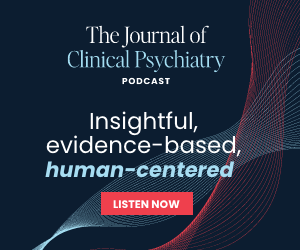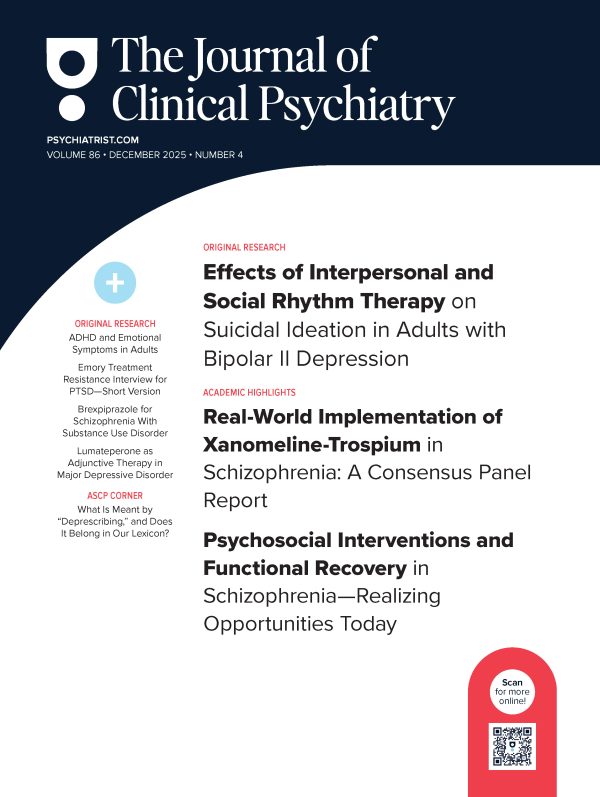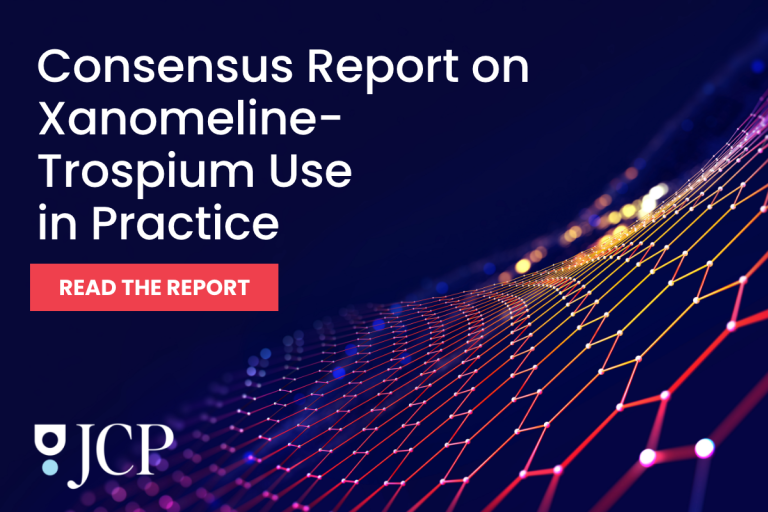ABSTRACT
Objective: Mild vitamin C deficiency is a psychiatrically relevant nutritional state, with symptoms including apathy, fatigue, and low mood. Although complete vitamin C deficiency has largely been eradicated, mild deficiency remains common in certain populations. Here, we aimed to identify the prevalence of mild vitamin C deficiency in the inpatient psychiatric setting.
Methods: We identified 221 patients with plasma vitamin C levels collected on an inpatient psychiatric unit serving a metropolitan area between January 1, 2015, and March 7, 2022. We identified demographic (age, sex, race, housing status, Area Deprivation Index [an index of neighborhood disadvantage]), substance use (tobacco use, alcohol use), diagnostic (depressive, bipolar, psychotic, anxiety, substance use, catatonia, neurocognitive, autism spectrum), and micronutrient (folate, vitamin B12, vitamin D) risk factors. DSM-5-TR was used as the diagnostic system. Bayesian log-normal regressions were constructed to predict vitamin C as a function of these risk factors. We used these same models to predict vitamin C as a function of significant risk factors.
Results: We found that 64% (141 of 221; 95% confidence interval 57%–70%) of patients met criteria for mild vitamin C deficiency. While we did not identify robust demographic, substance use, or diagnostic-based risk factors, we found that folate and vitamin D strongly predicted vitamin C levels. To test the utility of these predictors, we simulated vitamin C as a function of folate and vitamin D and found that predicted deficiency remained high (∼ 50%–55%), even when folate/vitamin D were sufficiently replete.
Conclusions: We find that vitamin C deficiency is highly prevalent in the inpatient psychiatric setting and remains high even when the relevant risk factor profile is favorable.
J Clin Psychiatry 2023;84(4):22m14616
Author affiliations are listed at the end of this article.
Members Only Content
This full article is available exclusively to Professional tier members. Subscribe now to unlock the HTML version and gain unlimited access to our entire library plus all PDFs. If you’re already a subscriber, please log in below to continue reading.
References (66)

- Georg E. Stern Ludwig. Papyros Ebers: das Hermetische Buch u¨ber die Arzneimittel der alten A¨gypter in hieratischer Schrift. Engelmann; 1875.
- Ebbell B. The Papyrus Ebers: The Greatest Egyptian Medical Document. Levin & Munksgaard; 1937.
- World Health Organization. Scurvy and Its Prevention and Control in Major Emergencies Tech Rep. World Health Organization; 1999.
- Hodges RE, Hood J, Canham JE, et al. Clinical manifestations of ascorbic acid deficiency in man. Am J Clin Nutr. 1971;24(4):432–443. PubMed CrossRef
- Combs GF, McClung JP. Vitamin C in The Vitamins: Fundamental Aspects in Nutrition and Health. 5th ed. Elsevier; 2017:267–295.
- Lind J. A Treatise on the Scurvy. Sands, Murray, and Cochran; 1757.
- Martini E. How did Vasco da Gama sail for 16 weeks without developing scurvy? Lancet. 2003;361(9367):1480. PubMed CrossRef
- Ravenstein Ernst Georg. A Journal of the First Voyage of Vasco da Gama, 1497–1499. Hakluyt Society; 2017.
- Institute of Medicine. Dietary Reference Intakes for Vitamin C, Vitamin E, Selenium, and Carotenoids. The National Academies Press; 2000.
- Magiorkinis E, Beloukas A, Diamantis A. Scurvy: past, present and future. Eur J Intern Med. 2011;22(2):147–152. PubMed CrossRef
- John W. The Surgions Mate. The First Compendium on Naval Medicine, Surgery and Drug Therapy (London 1617). Birkhauser; 1617.
- Shapter T. On the recent occurrence of scurvy in Exeter and the neighbourhood. Prov Med Surg J. 1847;11(11):281–285. PubMed
- Kinsman RA, Hood J. Some behavioral effects of ascorbic acid deficiency. Am J Clin Nutr. 1971;24(4):455–464. PubMed CrossRef
- Levine M, Conry-Cantilena C, Wang Y, et al. Vitamin C pharmacokinetics in healthy volunteers: evidence for a recommended dietary allowance. Proc Natl Acad Sci U S A. 1996;93(8):3704–3709. PubMed CrossRef
- Buzina R, Suboticanec K. Vitamin C and physical working capacity. Int J Vitam Nutr Res suppl. 1985;27:157–166. PubMed
- Plevin D, Galletly C. The neuropsychiatric effects of vitamin C deficiency: a systematic review. BMC Psychiatry. 2020;20(1):315. PubMed
- Rowe S, Carr AC. Global vitamin C status and prevalence of deficiency: a cause for concern? Nutrients. 2020;12(7):1–20. PubMed
- Johnston CS, Thompson LL. Vitamin C status of an outpatient population. J Am Coll Nutr. 1998;17(4):366–370. PubMed CrossRef
- Schleicher RL, Carroll MD, Ford ES, et al. Serum vitamin C and the prevalence of vitamin C deficiency in the United States: 2003–2004 National Health and Nutrition Examination Survey (NHANES). Am J Clin Nutr. 2009;90(5):1252–1263. PubMed CrossRef
- Hercberg S, Preziosi P, Galan P, et al. Vitamin status of a healthy French population: dietary intakes and biochemical markers. Int J Vitam Nutr Res. 1994;64(3):220–232. PubMed
- Malmauret L, Leblanc J, Cuvelier I, et al. Dietary intakes and vitamin status of a sample of homeless people in Paris. Eur J Clin Nutr. 2002;56(4):313–320. PubMed CrossRef
- Fain O, Pariés J, Jacquart B, et al. Hypovitaminosis C in hospitalized patients. Eur J Intern Med. 2003;14(7):419–425. PubMed CrossRef
- Gariballa S, Forster S. Effects of acute-phase response on nutritional status and clinical outcome of hospitalized patients. Nutrition. 2006;22(7-8):750–757. PubMed CrossRef
- Mosdøl A, Erens B, Brunner EJ. Estimated prevalence and predictors of vitamin C deficiency within UK’s low-income population. J Public Health (Oxf). 2008;30(4):456–460. PubMed CrossRef
- Gan R, Eintracht S, Hoffer LJ. Vitamin C deficiency in a university teaching hospital. J Am Coll Nutr. 2008;27(3):428–433. PubMed CrossRef
- Evans-Olders R, Eintracht S, Hoffer LJ. Metabolic origin of hypovitaminosis C in acutely hospitalized patients. Nutrition. 2010;26(11-12):1070–1074. PubMed CrossRef
- Zhang M, Robitaille L, Eintracht S, et al. Vitamin C provision improves mood in acutely hospitalized patients. Nutrition. 2011;27(5):530–533. PubMed CrossRef
- Gabb G, Gabb B. Scurvy not rare. Aust Fam Physician. 2015;44(7):438–440. PubMed
- Da Cunha DF, Cunha SF, Unamuno MR, et al. Serum levels assessment of vitamin A, E, C, B2 and carotenoids in malnourished and non-malnourished hospitalized elderly patients. Clin Nutr. 2001;20(2):167–170. PubMed CrossRef
- Avelino DD, Maltos AL, Portari GV, et al. Vitamin C status in hospitalized adults according to subjective global assessment method. JPEN J Parenter Enteral Nutr. 2019;43(6):789–793. PubMed CrossRef
- García OP, Ronquillo D, del Carmen Caamaño M, et al. Zinc, vitamin A, and vitamin C status are associated with leptin concentrations and obesity in Mexican women: results from a cross-sectional study. Nutr Metab (Lond). 2012;9(1):59. PubMed CrossRef
- Villalpando S, Montalvo-Velarde I, Zambrano N, et al. Vitamins A, and C and folate status in Mexican children under 12 years and women 12-49 years: a probabilistic national survey. Salud Publica Mex. 2003;45(suppl 4):S508–S519. PubMed CrossRef
- Hamer DH, Sempértegui F, Estrella B, et al. Micronutrient deficiencies are associated with impaired immune response and higher burden of respiratory infections in elderly Ecuadorians. J Nutr. 2009;139(1):113–119. PubMed CrossRef
- Lam TK, Freedman ND, Fan J-H, et al. Prediagnostic plasma vitamin C and risk of gastric adenocarcinoma and esophageal squamous cell carcinoma in a Chinese population. Am J Clin Nutr. 2013;98(5):1289–1297. PubMed CrossRef
- Frankenfeld CL, Lampe JW, Shannon J, et al. Fruit and vegetable intakes in relation to plasma nutrient concentrations in women in Shanghai, China. Public Health Nutr. 2012;15(1):167–175. PubMed CrossRef
- Viroonudomphol D, Mahaisiriyodom A, Mingkhawn R, et al. Relationship between serum antioxidant vitamins A, E, and C and lipid profiles in priest subjects at the Priest Hospital. Southeast Asian J Trop Med Public Health. 2005;36(suppl 4):246–253. PubMed
- Ravindran RD, Vashist P, Gupta SK, et al. Prevalence and risk factors for vitamin C deficiency in north and south India: a two centre population based study in people aged 60 years and over. PLoS One. 2011;6(12):e28588. PubMed CrossRef
- Nwagha UI, Iyare EE, Ejezie FE, et al. Parity related changes in obesity and some antioxidant vitamins in non-pregnant women of South-Eastern Nigeria. Niger J Clin Pract. 2012;15(4):380–384. PubMed CrossRef
- Kiondo P, Tumwesigye NM, Wandabwa J, et al. Plasma vitamin C assay in women of reproductive age in Kampala, Uganda, using a colorimetric method. Trop Med Int Health. 2012;17(2):191–196. PubMed CrossRef
- Bush K, Kivlahan DR, McDonell MB, et al. The AUDIT alcohol consumption questions (AUDIT-C): an effective brief screening test for problem drinking. Ambulatory Care Quality Improvement Project (ACQUIP). Alcohol Use Disorders Identification Test. Arch Intern Med. 1998;158(16):1789–1795. PubMed CrossRef
- Kind AJH, Buckingham WR. Making neighborhood-disadvantage metrics accessible—the neighborhood atlas. N Engl J Med. 2018;378(26):2456–2458. PubMed CrossRef
- University of Wisconsin School of Medicine and Public Health. Area Deprivation Index. Version 3.0. 2019. Accessed March 11, 2022. https://www.neighborhoodatlas.medicine.wisc.edu/
- Singh GK. Area deprivation and widening inequalities in US mortality, 1969-1998. Am J Public Health. 2003;93(7):1137–1143. PubMed CrossRef
- Kind AJH, Jencks S, Brock J, et al. Neighborhood socioeconomic disadvantage and 30-day rehospitalization: a retrospective cohort study. Ann Intern Med. 2014;161(11):765–774. PubMed CrossRef
- American Psychiatric Association. Diagnostic and Statistical Manual of Mental Disorders DSM-5-TR. Fifth Edition, Text Revision. American Psychiatric Association. 2022.
- Nayak SM, Bari BA, Yaden DB, et al. A Bayesian reanalysis of a trial of psilocybin versus escitalopram for depression. Psychedelic Med. 2022;1(1):18–26.
- Keysers C, Gazzola V, Wagenmakers EJ. Using Bayes factor hypothesis testing in neuroscience to establish evidence of absence. Nat Neurosci. 2020;23(7):788–799. PubMed CrossRef
- Quintana DS, Williams DR. Bayesian alternatives for common null-hypothesis significance tests in psychiatry: a non-technical guide using JASP. BMC Psychiatry. 2018;18(1):178. PubMed CrossRef
- Bürkner P-C. Advanced Bayesian multilevel modeling with the R Package brms. R J. 2018;10(1):395–411. CrossRef
- Stan Development Team. Stan Modeling Language Users Guide and Reference Manual. Version 2.30. 2022. https://github.com/stan-dev/stan/releases
- Makowski D, Ben-Shachar MS, Chen SHA, et al. Indices of effect existence and significance in the Bayesian framework. Front Psychol. 2019;10:2767. PubMed
- Dominique M, Ben-Shachar MS, Daniel L. bayestestR: describing effects and their uncertainty, existence and significance within the Bayesian framework. J Open Source Softw. 2019;4:1–18.
- Hodges RE, Baker EM, Hood J, et al. Experimental scurvy in man. Am J Clin Nutr. 1969;22(5):535–548. PubMed CrossRef
- Ashor AW, Siervo M, Mathers JC. Vitamin C, Antioxidant Status, and Cardiovascular Aging in Molecular Basis of Nutrition and Aging. Elsevier; 2016:609–619.
- Adrianne B. Vitamin C Safety in Humans in Vitamin C in Health and Disease. In: Packer L, Fuchs J, eds. Marcel Dekker; 1997:367–379.
- Frei B, Trabe MG. The new US Dietary Reference Intakes for vitamins C and E. Redox Rep. 2001;6(1):5–9. PubMed CrossRef
- Dipasquale S, Pariante CM, Dazzan P, et al. The dietary pattern of patients with schizophrenia: a systematic review. J Psychiatr Res. 2013;47(2):197–207. PubMed CrossRef
- Dohrenwend BP. Socioeconomic status (SES) and psychiatric disorders: are the issues still compelling? Soc Psychiatry Psychiatr Epidemiol. 1990;25(1):41–47. PubMed CrossRef
- Allen LH. How common is vitamin B-12 deficiency? Am J Clin Nutr. 2009;89(2):693S–696S. PubMed CrossRef
- Cashman KD. Vitamin D deficiency: defining, prevalence, causes, and strategies of addressing. Calcif Tissue Int. 2020;106(1):14–29. PubMed CrossRef
- Carr AC, Rowe S. Factors affecting vitamin C status and prevalence of deficiency: a global health perspective. Nutrients. 2020;12(7):1963. PubMed CrossRef
- Ridge BD, Fairhurst E, Chadwick D, et al. Ascorbic acid concentrations in human plasma and cerebrospinal fluid [proceedings]. Proc Nutr Soc. 1976;35(2):57A–58A. PubMed
- Brown TM. Neuropsychiatric scurvy. Psychosomatics. 2015;56(1):12–20. PubMed CrossRef
- Mazloom Z, Ekramzadeh M, Hejazi N. Efficacy of supplementary vitamins C and E on anxiety, depression and stress in type 2 diabetic patients: a randomized, single-blind, placebo-controlled trial. Pak J Biol Sci. 2013;16(22):1597–1600. PubMed
- Brody S. High-dose ascorbic acid increases intercourse frequency and improves mood: a randomized controlled clinical trial. Biol Psychiatry. 2002;52(4):371–374. PubMed CrossRef
- Yosaee S, Keshtkaran Z, Abdollahi S, et al. The effect of vitamin C supplementation on mood status in adults: a systematic review and meta-analysis of randomized controlled clinical trials. Gen Hosp Psychiatry. 2021;71:36–42. PubMed CrossRef






